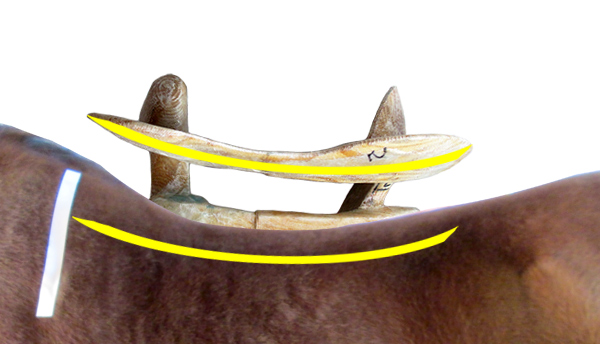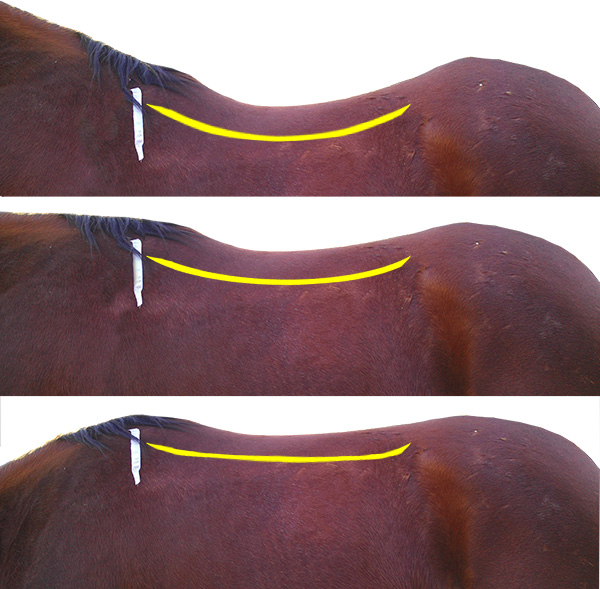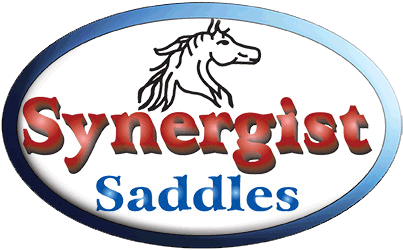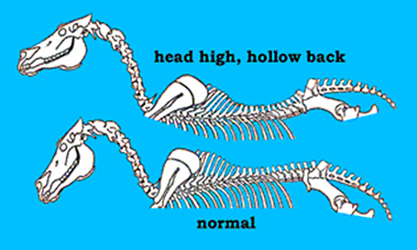 I came across a website the other day that had instructions on how to do tracings at various places along the horse’s back. It also said to do a tracing along top line of the horse. While this may sound logical, the saddle does not sit on the top line. It sits on the rock line. Rock is the front to back curvature of the horse’s back where the bars of the tree make contact. Rock also describes the front to back curvature of the bottom of the bars on the tree. When these match we have a happy horse.
I came across a website the other day that had instructions on how to do tracings at various places along the horse’s back. It also said to do a tracing along top line of the horse. While this may sound logical, the saddle does not sit on the top line. It sits on the rock line. Rock is the front to back curvature of the horse’s back where the bars of the tree make contact. Rock also describes the front to back curvature of the bottom of the bars on the tree. When these match we have a happy horse.
While the top line of the horse is readily apparent when viewing a horse from the side, as saddle fitters we need to look at the back of a horse differently and focus on the area on either side of the spine instead of the top line. What we are actually fitting is the ribcage and the layer of muscles that cover it not the top line.
 Another thing to keep in mind when looking at the rock of a horse’s back is the position of the head. The moving horse is dynamically changing as he moves. Unfortunately we have to assess the back of a standing horse when we fit him. The best we can do to accommodate the moving horse is to try to find a neutral position when he is standing. We need to have the horse standing squarely with weight on all four feet as well as the horse’s head at the same height as when he is moving. When a horse lowers his head like when he’s grazing the back comes up and flattens the rock. Alternately he moves his head up the middle of the back lowers and the rock deepens.
Another thing to keep in mind when looking at the rock of a horse’s back is the position of the head. The moving horse is dynamically changing as he moves. Unfortunately we have to assess the back of a standing horse when we fit him. The best we can do to accommodate the moving horse is to try to find a neutral position when he is standing. We need to have the horse standing squarely with weight on all four feet as well as the horse’s head at the same height as when he is moving. When a horse lowers his head like when he’s grazing the back comes up and flattens the rock. Alternately he moves his head up the middle of the back lowers and the rock deepens.
It’s also important to keep the horse’s head straight forwards because when they turn their head to one side their body curves and the rock increases on the side they turn to and flattens a bit on the opposite side.
Types of Horses with More Than Average Rock
Sometimes having too much rock in a horse’s back is unhealthy so it’s important to look at why there is so much rock. In cases of horses with unhealthy backs the more the rock, the more likely the tops of the spinous processes (the spires of the top of the vertebrae), where muscles and ligaments attach, will come in contact with each other. This is commonly known as ‘kissing spine’.
Horses that have a hollow area right behind the shoulder blades usually need more rock in the tree. You see these hollows on horses that may have muscle atrophy from ill-fitting saddles, or are skinny hard keeper type horses or horses that are just naturally a thin build. Without a nice layer of muscle over and behind the shoulder blade the hollow area becomes more apparent. The bigger the hollow is behind the shoulder blade, the more rock is needed in the front of the bars so the tree doesn’t interfere with the shoulder blade as it rotates back.
Older horses that don’t get regular exercise generally show more rock. As muscles weaken, especially the abdominals, the spine starts to sag from the lack of muscle support. We’ve fit horses in their twenty’s that were still competing in 50 mile endurance rides because the riders kept their exercise level consistent as they aged.
A lot of ‘downhill horses’, those that are higher in the croup than the wither, need more rock in the back of the bars so the saddle won’t poke into the loin area. As the rise to the croup increases so should the rock.
A fat and out of shape younger horse can easily, through proper exercise, build up the muscles that support the back but an older horse that has not been riden for years is not going to get the same results. Strong abdominal muscles mean a healthy back which will extend the rideable life of the horse.
Really muscled up horses sometimes need more than average rock. The horses back is made up of bigger muscles in the shoulder area and also bigger muscles that extend forward from the croup with an area in between that are longer flatter muscles. More rock is needed to accommodate the dip that naturally forms between the larger shoulder muscles and larger muscles of the hind end.
A lot of smaller horses need more rock simply because the shortness of the back moves the hip closer to the shoulder blade making it necessary to have more rock in the back so the tails of the bars don’t dig into the loin.
So when we look at a horse’s back when evaluating for saddle fit remember it’s the rock line not the top line that determines the shape of the bars. If a horse has a lot of rock it’s also important to know where it is and why. In some cases we as saddle makers just have to level with the customer and tell them that their horse’s back is in trouble and is going to need some work before we can fit him with a saddle.


Comments 2
This was very helpful.!!
This is the most helpful article I’ve read on saddle fitting and trust me I’ve read a lot! I have an Arab who is a saddle fitting nightmare. Thank you for this thorough explanation!